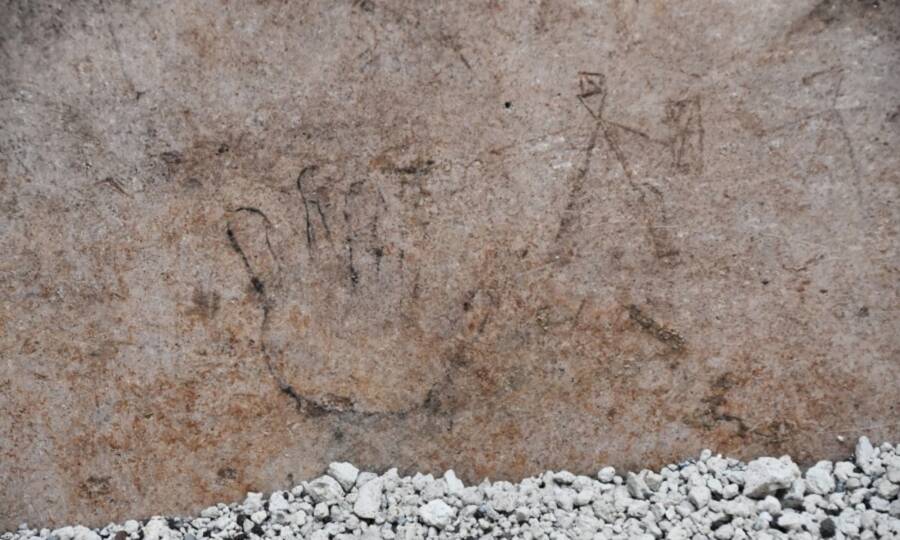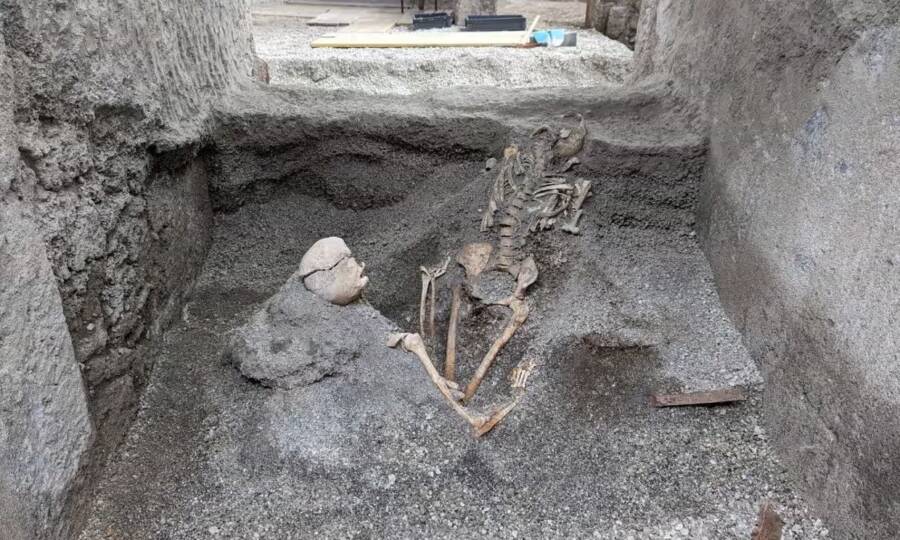Found on a courtyard wall, these charcoal drawings depict an intense gladiator battle, an animal hunt, and the outlines of three small hands.

Parco Archeologico di PompeiThis gladiator graffiti offers a glimpse at what Pompeii’s children witnessed in the doomed city not long before its destruction.
Children often draw the things they see: dogs, flowers, their families, and so on. Children thousands of years ago, naturally, did the same thing. And recently, archaeologists working in Pompeii uncovered graffiti likely left by some of the city’s youngest residents, which depict scenes of what they once witnessed, including gladiator fights.
These scenes reveal a great deal about what children in Pompeii saw in their day-to-day lives and how they may have routinely encountered violence like gladiator battles and animal hunts.
The Discovery Of The Gladiator Graffiti At Pompeii
The gladiator graffiti, described in the Pompeii Archaeological Park’s E-Journal of the Pompeii Excavations, was discovered during excavations at homes within the I’Insula dei Casti Amanti on the Via dell’Abbondanza.
According to an Instagram post from the Pompeii Archaeological Park, the graffiti was left in charcoal on the wall of a courtyard, likely by children between the ages of five and seven years old. The drawings were possibly made just a few months before the eruption of Mount Vesuvius destroyed the ancient Roman city in 79 C.E., killing at least 2,000 people in the city proper.
“There is a drawing, arranged at two levels,” archaeologists explained to All That’s Interesting in an email, “one portrays a gladiatorial scene, with two facing gladiators, and a hunting scene, with two bestiarii [Romans who fought animals], equipped with long spears, facing what could possibly be identified as a pair of wild boars.”

Parco Archeologico di PompeiThe outline of a small hand that was also left on the wall.
The archaeologists continued: “On the right, we find the silhouette of the head of a bird of prey seen in profile…[Elsewhere] you can see at least three small hands outlined with charcoal, two gladiatorial scenes, a drawing that seems to portray two figures playing with a ball, an animal that is likely to be a wild boar and, finally, a boxing scene, portraying one of the two boxers lying on the ground.”
According to the journal article, the children drew “what was the great passion…of the time: fights between gladiators, boxers and venationes…”
Indeed, the children were probably not reproducing images from stories they heard, but from things they had actually witnessed. Gladiator fights in Pompeii, archaeologists told All That’s Interesting in an email, were likely “bloody, fierce, and sometimes deadly.”
“In fact, it seems probable that the model is not artistic…” the journal’s authors further explained. “Rather, they are attempts to reproduce, with figurative language precisely from that age, something really observed.”
On Instagram, the archaeological park noted that the drawings show that children in Pompeii were exposed to “extreme forms of violence.” But unlike today, where children’s exposure to violence in video games and social media can cause concern, few in Pompeii would have seen this exposure as a “problem” or fretted about its impact on the children’s development.
But the gladiator graffiti is not the only thing that archaeologists recently uncovered in Pompeii.
Other Recent Finds Among The Ruins Of Pompeii
Archaeologists also made another stunning discovery in Pompeii recently: two bodies by the door of a building known as the “House of the Painters at Work” (because its owners were repainting it when Mount Vesuvius erupted).

Parco Archeologico di PompeiArchaeologists also discovered two bodies near the doorway of a home known as “House of the Painters at Work.”
To date, not much is known about the two bodies, aside from the fact that one is a man and one is a woman.
But they’re just one of many recent discoveries that archaeologists have made at the doomed city. In recent months, archaeologists have also uncovered a construction site that demonstrated ancient building techniques, a mat-making workshop and restaurant, stunning frescoes from an elaborate dining room, and a bakery where enslaved workers and donkeys toiled under tortuous conditions.
Each discovery adds another piece in the puzzle of Pompeii. Though the doomed city was destroyed by Mount Vesuvius in 79 C.E., it continues to yield discoveries that can help us better understand what life was like for its inhabitants just before Pompeii was wiped out forever.
After reading about the gladiator graffiti discovered in Pompeii, look through these disturbing photos of Pompeii bodies frozen in time from when Mount Vesuvius erupted and destroyed the city. Then, discover the wild story of Baiae, the sunken party town of ancient Rome.





